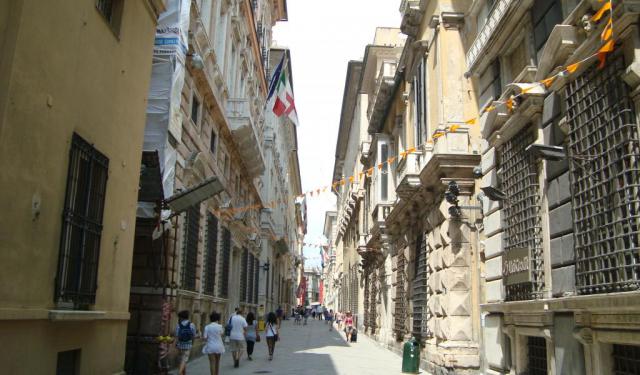Palazzo San Giorgio (Palace of St. George), Genoa
The Byzantine Emperor Michael VIII felt indebted to Genoa. Genoa had been his ally in a war against the Latin Empire. To show his appreciation, Emperor Michael donated material stripped from the Venetian embassy in Constantinople to Guglielmo Boccanegra. Boccanegra used the material to build his waterfront dream palace. The year was 1260.
Stone lions, the emblem of Venice's patron, Saint Mark, soon decorated the facade of Guglielmo's grand palace. But two years later, Boccanegra was deposed as Captain of the People and forced into exile. The building became a prison. Marco Polo was the most famous prisoner. He dictated his memoirs to Rustichello of Pisa, a romance writer best known for co-writing Marco Polo's autobiography, The Travels of Marco Polo, while they were in prison together.
The palace, among other things, was intended to be the headquarters for port authorities. Design was by Frate Oliverio, a Cistercian monk. In 1400 the building became the home of the Bank of San Giorgio, one of Italy's first banks.
In 1570 an East wing was added to hold customs offices, archives, and bank vaults. In 1608 the main facade was painted with heroic frescos, the center fresco featuring Saint George and the dragon. A clock tower was erected on the roof over the facade's center.
On the facade are niches holding statues of heroic figures of Genoa's past. They are Christopher Columbus, Andrea Doria, Biagio Assereto, Simone Boccanegra, Guglielmo Embriaco, and Caffaro di Rustico. Presently the Palace of St. George is the administrative center of the Port.
Stone lions, the emblem of Venice's patron, Saint Mark, soon decorated the facade of Guglielmo's grand palace. But two years later, Boccanegra was deposed as Captain of the People and forced into exile. The building became a prison. Marco Polo was the most famous prisoner. He dictated his memoirs to Rustichello of Pisa, a romance writer best known for co-writing Marco Polo's autobiography, The Travels of Marco Polo, while they were in prison together.
The palace, among other things, was intended to be the headquarters for port authorities. Design was by Frate Oliverio, a Cistercian monk. In 1400 the building became the home of the Bank of San Giorgio, one of Italy's first banks.
In 1570 an East wing was added to hold customs offices, archives, and bank vaults. In 1608 the main facade was painted with heroic frescos, the center fresco featuring Saint George and the dragon. A clock tower was erected on the roof over the facade's center.
On the facade are niches holding statues of heroic figures of Genoa's past. They are Christopher Columbus, Andrea Doria, Biagio Assereto, Simone Boccanegra, Guglielmo Embriaco, and Caffaro di Rustico. Presently the Palace of St. George is the administrative center of the Port.
Want to visit this sight? Check out these Self-Guided Walking Tours in Genoa. Alternatively, you can download the mobile app "GPSmyCity: Walks in 1K+ Cities" from Apple App Store or Google Play Store. The app turns your mobile device to a personal tour guide and it works offline, so no data plan is needed when traveling abroad.
Palazzo San Giorgio (Palace of St. George) on Map
Sight Name: Palazzo San Giorgio (Palace of St. George)
Sight Location: Genoa, Italy (See walking tours in Genoa)
Sight Type: Attraction/Landmark
Guide(s) Containing This Sight:
Sight Location: Genoa, Italy (See walking tours in Genoa)
Sight Type: Attraction/Landmark
Guide(s) Containing This Sight:
Walking Tours in Genoa, Italy
Create Your Own Walk in Genoa
Creating your own self-guided walk in Genoa is easy and fun. Choose the city attractions that you want to see and a walk route map will be created just for you. You can even set your hotel as the start point of the walk.
Genoa Introduction Walking Tour
Petrarch, an Italian poet of the early Renaissance known as the "father of humanism," called Genoa "La Superba" (The Proud One). Genoa is deservedly proud of her maritime glory and unique architecture.
From the 11th century until the late 18th century, the city became a leading economic and military power in Europe. It was one of the wealthiest cities in the world through... view more
Tour Duration: 2 Hour(s)
Travel Distance: 3.8 Km or 2.4 Miles
From the 11th century until the late 18th century, the city became a leading economic and military power in Europe. It was one of the wealthiest cities in the world through... view more
Tour Duration: 2 Hour(s)
Travel Distance: 3.8 Km or 2.4 Miles
Rolli Palaces Walking Tour
The Rolli di Genova – or, more precisely, the Rolli degli alloggiamenti pubblici di Genova (Italian for "Lists of the public lodgings of Genoa") – were first established in the Republic of Genoa in 1576. Originally, these official lists included private palaces and mansions belonging to the most distinguished local families, which - if chosen through a public lottery - were obliged... view more
Tour Duration: 1 Hour(s)
Travel Distance: 0.4 Km or 0.2 Miles
Tour Duration: 1 Hour(s)
Travel Distance: 0.4 Km or 0.2 Miles





